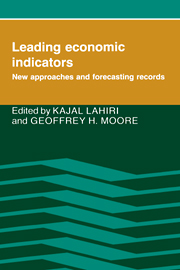Book contents
- Frontmatter
- Contents
- Preface
- List of contributors
- 1 Introduction
- PART I NEW CONCEPTS AND METHODS
- PART II FORECASTING RECORDS AND METHODS OF EVALUATION
- PART III NEW ECONOMIC INDICATORS
- 17 Commodity prices as a leading indicator of inflation
- 18 A leading indicator of inflation based on interest rates
- 19 Using composite leading indicators of consumption to forecast sales and to signal turning points in the stock market
- 20 Economic indicators for Australia's service sector
- 21 Purchasing management survey data: Their value as leading indicators
- 22 An agenda for inventories input to the leading composite index
- Index
21 - Purchasing management survey data: Their value as leading indicators
Published online by Cambridge University Press: 05 June 2012
- Frontmatter
- Contents
- Preface
- List of contributors
- 1 Introduction
- PART I NEW CONCEPTS AND METHODS
- PART II FORECASTING RECORDS AND METHODS OF EVALUATION
- PART III NEW ECONOMIC INDICATORS
- 17 Commodity prices as a leading indicator of inflation
- 18 A leading indicator of inflation based on interest rates
- 19 Using composite leading indicators of consumption to forecast sales and to signal turning points in the stock market
- 20 Economic indicators for Australia's service sector
- 21 Purchasing management survey data: Their value as leading indicators
- 22 An agenda for inventories input to the leading composite index
- Index
Summary
In the ongoing effort to utilize and improve the forecasting properties of leading indicators, analysts on both sides of the Atlantic and Pacific are increasingly combining quantitative indicators of the sort pioneered by Arthur F. Burns and Wesley C. Mitchell with qualitative survey data. We have in the past considered the forecasting usefulness of a number of surveys, including the surveys conducted by the European Economic Community, the Confederation of British Industry in the United Kingdom, Dun and Bradstreet, Inc., and the Michigan Survey Research Center in the United States. In a paper we presented at the September 1985 meeting of CIRET in Vienna, we explored some of the forecasting properties of the price surveys conducted by the National Association of Purchasing Management (NAPM) in the United States (Moore and Klein, 1985). One of the unique features of this survey is that it reports buying prices rather than selling prices, and we examined some of the relationships between this survey and measures of price fluctuations.
The preliminary work with the NAPM data proved so promising that we here concentrate on this source and develop the analysis not only of prices but also of other leading indicators, namely, new orders, inventory change, and vendor performance. In each case we shall compare the turning points in the NAPM series with the U.S. business cycle chronology as well as with comparable quantitative series. Correlation analyses will also be used. In this way we can evaluate the overall usefulness for forecasting of a data set that we believe has been underutilized thus far.
- Type
- Chapter
- Information
- Leading Economic IndicatorsNew Approaches and Forecasting Records, pp. 403 - 428Publisher: Cambridge University PressPrint publication year: 1991
- 4
- Cited by



